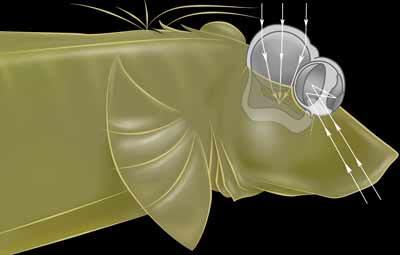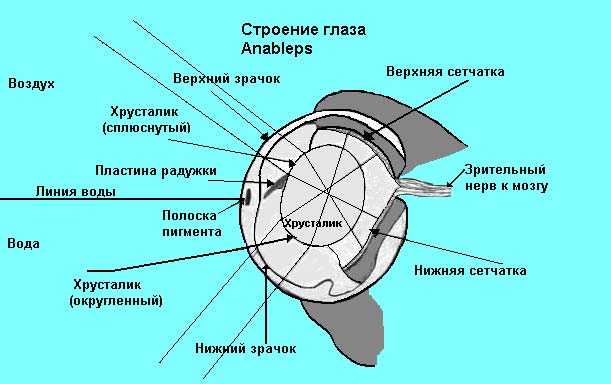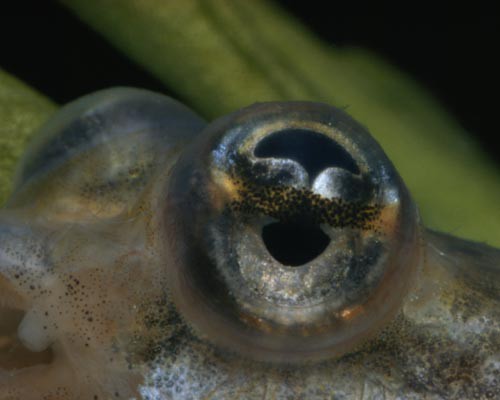Physics in the animal world: "four-eyed" fish and their "optical instruments"

Deep-sea fish of the Opistoprotect family have been known for a long time. They were first described over a hundred years ago. At first glance, this is an unremarkable fish that lives where almost total darkness reigns. Why do the inhabitants of such places have their eyes? And yet, most of the representatives of the species of this family can see, and quite well. This is possible due to the original structure of their eyes.
They are tubular in shape and directed upwards. In fish, this is not such a rare phenomenon - for example, the eyes of a telescope aquarium fish are directed upwards. But Opistoprocta eyes are tubular, not round. They resemble a telescope, not an eyeball. And the structure of this telescope is very unusual.
 The fact is that each eye is divided. The part of the eye that is facing up receives an image of what is above, what is logical. The second part of the eye is directed downwards. A mirror surface is used to focus the image here. The light, falling on the inside of the second half of the eye, is reflected and focused. The mirror has a very unusual nature, these are plates of silvery crystals, which are arranged in the form of scales adjacent to each other.
The fact is that each eye is divided. The part of the eye that is facing up receives an image of what is above, what is logical. The second part of the eye is directed downwards. A mirror surface is used to focus the image here. The light, falling on the inside of the second half of the eye, is reflected and focused. The mirror has a very unusual nature, these are plates of silvery crystals, which are arranged in the form of scales adjacent to each other.Scientists believe that the crystals of the fish eye mirror are guanine. Thanks to guanine, fish scales glistens. The flake crystals are arranged in several layers in a certain order, due to which the angle of flakes changes with distance from the center of the “mirror”. Scientists conducted a simulation of the principle of the action of such an eye, and it turned out that placing crystals in the mirror allows the fish to get a clearly focused image. The bottom half helps the fish observe luminescent organisms at depth. Rising into layers, where the light is a little more, the fish can see everything that happens above it, in front of it and on the sides. These fish have almost circular vision.

In the photo above (the fish is shown above), a reflection of light from the tubular eyes is noticeable. But diverticular eyes that look down do not shine. They would reflect the light only in one case - if the fish were photographed from below. The “mirror” in the secondary, diverticular eyes helps fish of the family to get a clear image of what comes into view. Thanks to its eyes, the fish can catch even weakly luminescent prey, or quickly recognize the enemy and escape.
The opistropic family includes 6 genera with 10 species. A number of species are very rare, some of them were discovered by chance. For example, species of Rhynchohyalus, Dolichopteryx, Winteria, Bathylychnops are known for only 3-5 specimens. Most members of the family live in tropical and moderately warm waters of the oceans. They prefer to live at a depth of 200 to 2500 meters.
Another fish, the species Anableps anableps , has a somewhat similar structure of its organ of vision .(chetyrehglazka). It does not live at depth, as members of the Opistoproct family, but practically on the surface. And most of the time fish spends in two environments at once - water and air. Her eye is divided into two parts by the water surface. The upper part is in the air, and the second half - under water.
The structure of the eye helps the fish to see everything that happens above the water, as well as what happens in the water. Her eye is divided into two parts by a layer of epithelial tissue. Even the lens has an unusual shape, it has an ovoid shape and can receive images from two sources at once. Some idea of the structure of the eye of a fish can give bifocal glasses, the lenses of which are also divided into two parts.

The upper part of the fish's eye is protected by a special stripe of the iris, which does not allow too bright sunshine to blind the fish. In these fish, not only the cornea of the eye is separated, but also the fundus of the eye, which is formed by the retina. The part of the lens that is in this part of the eye is slightly flattened, which makes it possible to give an undistorted image. In the lower half of the eye, the lens is convex and thickened, which also gives an accurate picture of what is happening around, without distortion. In the water and in the air, the four-eyed bird sees everything without distortion. And all thanks to the special structure of the eye and lens.

By the way, the fish often has to completely lower its head into the water in order to prevent the upper half of the eye from drying out. Thanks to the double eye, Anableps anableps can see prey in the air (it feeds on insects), and a predator in water. In addition, the fish immediately swims away if some animal or person approaches the water. Only chetyrehglazok three species. They inhabit the fresh and brackish waters of Central and South America.
